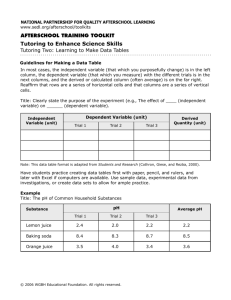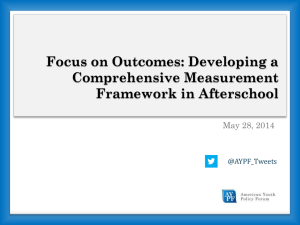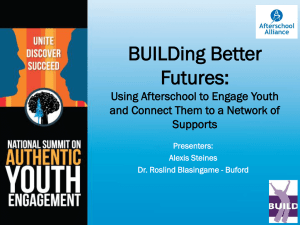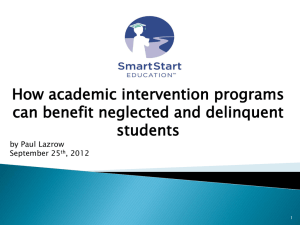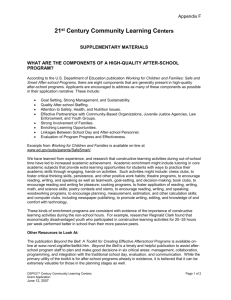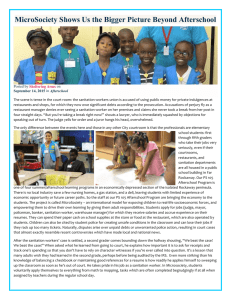Afterschool Physical Activity Resource Guide
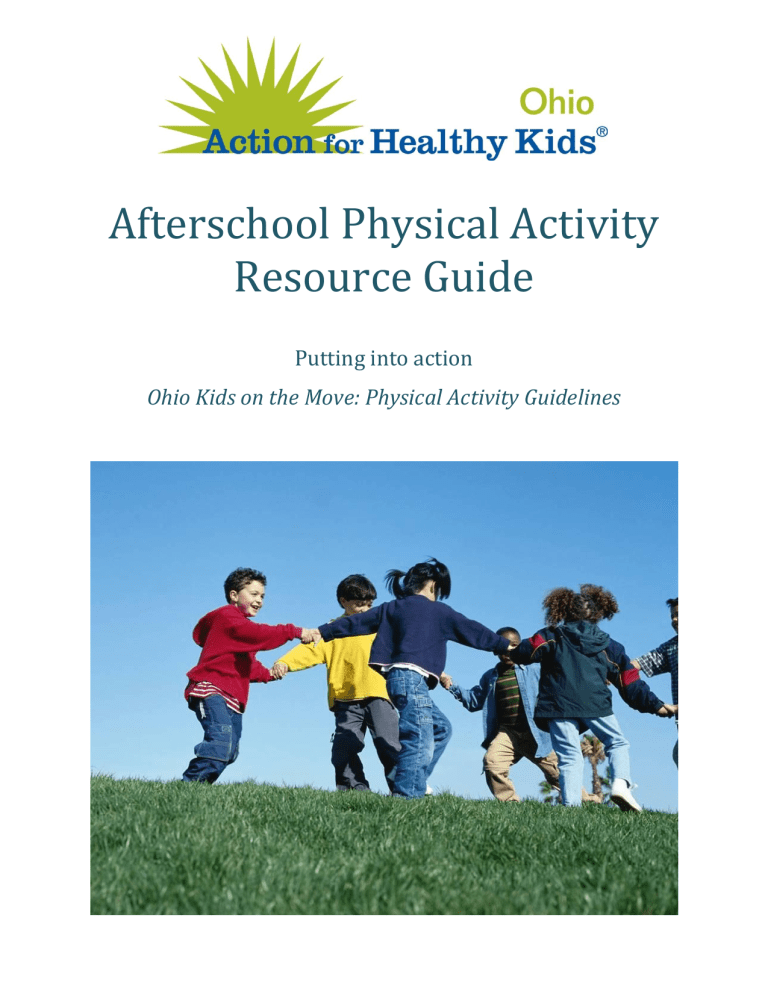
Afterschool Physical Activity
Resource Guide
Putting into action
Ohio Kids on the Move: Physical Activity Guidelines
Table of Contents
Introduction .................................................................................................................... 1
What is Physical Activity? ..................................................................................................... 2
Healthier Students are Better Learners ............................................................................. 3
Ohio Kids on the Move: Physical Activity Guidelines for Afterschool
Programs .......................................................................................................................... 3
Physical Activity Guidelines Chart ..................................................................................... 5
Action For Healthy Kids .............................................................................................. 6
Game On! ...................................................................................................................................... 6
Fuel Up to Play 60 .......................................................................................................................... 7
Students Taking Charge ......................................................................................................... 8
ReCharge! ..................................................................................................................................... 8
Examples of Physical Activities ............................................................................. 10
10-Minute Games For Small Spaces ................................................................................ 14
RPE Scale For Kids .................................................................................................................. 18
Family Involvement ................................................................................................... 19
Sample Parent Letter and Program Policies ..................................................... 21
Sample Parent Letter ............................................................................................................ 21
Sample Policies ........................................................................................................................ 22
Resources ...................................................................................................................... 23
2
Introduction
In Ohio, more than one-third of our children are either overweight or obese. According to the
Ohio Department of Health, of the 35.5 % of children ages 6-11 that are either overweight or obese, 19.6 percent of them are obese. This puts Ohio above the 15.7 percent goal set by the
Healthy People 2020 Objective for obesity among children aged 6 to 11 years old.
Healthy People 2020 physical activity goal is to improve the health, fitness and quality of life through daily physical activity. Some of their objectives specifically target school-age children and include reduction in screen time to no more than 2 hours a day, increase in daily physical education and regularly scheduled school recess, and increasing the proportion of trips made by walking and bicycling.
The USDA recommends that children and adolescents age 6 to 17 years of age should do 60 minutes or more of physical activity each day. Afterschool programs provide the perfect environment for youth to learn by doing. The less formal atmosphere offers opportunities for young people to be active.
With funding provided by the American Recovery Act, the Ohio Department of Health reached out to the Ohio Afterschool Network to Create Ohio Kids on the Move: Physical Activity
Guidelines for Afterschool Programs.
In collaboration with the Ohio Afterschool Network, Ohio Action for Healthy Kids has developed this physical activity resource packet to assist afterschool programs in implementing these guidelines.
Together, we can create healthy communities that give all Ohio children the chance to lead healthy lives.
3
What is Physical Activity?
Physical activity, broadly defined, is bodily movement that enhances or maintains physical fitness, overall health and wellness. Children and adolescents need 60 or more minutes of physical activity each day. Most of this time needs to be spent on moderate to vigorous-intensity aerobic physical activity, with vigorous-intensity physical activity at least three days a week.
This will increase heart rate and breathing well above normal which can result in a large number of physiological and psychological benefits.
Examples
Physical activity is bodily movement of any kind. It may include recreational activities such as jumping rope, playing soccer or roller-skating
Daily Activities:
Dog walking
Gardening
Raking leaves
Sweeping the house
Taking the stairs
Walking to school
Exercise is a subset of physical activity that is planned or structured. It is done to improve or maintain one or more of the components of physical fitness cardio-respiratory endurance (aerobic fitness), muscular strength and endurance, flexibility and body composition.
Exercises:
Aerobics
Pilates
Push-ups
Resistance bands
Sit-ups
Weight lifting
Yoga
Zumba
4
Healthier Students are Better Learners
Many afterschool programs focus on supporting school learning by helping with homework, providing tutoring and learning supports due to parent, teacher and funder expectations.
Keeping kids focused and on-task is increasingly important in order to improve test scores and meet the requirements of afterschool program funders. At the same time, physical activity in schools has been reduced or eliminated while our children have become more sedentary than ever. Regular physical activity has been proven to provide many positive outcomes for children in addition to improved fitness including:
Higher test scores
Improved self-esteem
Increased concentration
Reduced anxiety
Better behavior
Ohio Kids on the Move: Physical Activity Guidelines for
Afterschool Programs
The Ohio Kids on the Move: Physical Activity Guidelines for Afterschool Programs is a document that is the result of collaboration and contributions from stakeholders from across the state with a wide range of expertise – including physical educators, teachers, public health professionals, policymakers, and front-line afterschool personnel. The following chart aims to identify and define the ten guidelines of physical activity in which staff and caregivers of children grades K-12 can strive to gain knowledge and skill. This document provides sample activities and resources that can be implemented in after school programs. For more information about these guidelines go to the Ohio Afterschool Network website, www.ohioafterschoolnetwork.org.
5
Ohio Kids on the Move: Physical Activity Guidelines for Afterschool Programs
Guideline Description
Types of
Activities
Children of all ages and fitness levels are able to participate in physical activity and feel successful.
Time and
Intensity
The afterschool program provides an amount and intensity of moderate-to-vigorous physical activity that contributes to the recommended 60 minutes or more daily.
Curriculum
Qualified Staff
Physical activity is a planned part of the afterschool program and staff members are intentional about planning rich and meaningful experiences to enhance learning. It is ageappropriate, child-centered, integrated, and individually and group goal oriented.
The afterschool program staff is competent in promoting physical activity and is supported by ongoing training and development.
Implementation
See pages 10-17 for group games and activities.
60 minutes of physical activity does not have to be done all at one time. Short 10-minute activity breaks can really add up. See pages 14-17 for quick 5-10 minute activities and p.18 for Relative Perceived Exertion Scale For Kids.
Engage children in curriculum planning and decisionmaking. Encourage children to set personal and group goals and acknowledge them when they reach those goals.
Ratio
Program
Policies and
Administration
Evaluation
Facilities
Equipment
Family, School and Community
Program staff is able to adequately engage and supervise all children safely in physical activity with a ratio of at least 1:15.
The afterschool program’s administration and policies assure integration of physical activity in the program’s infrastructure, culture and curriculum.
Curriculum planning is informed by ongoing and appropriate assessment. Measurements can include; is physical activity offered as planned? Do participants and staff transition easily from one activity to another? Is staff comfortable leading?
Are participants more physically active during the time they are in the after-school program?
The afterschool program provides safe, healthy, and appropriate indoor and outdoor facilities for program physical activities. Safety considerations include space for children and adolescents to safely move without bumping into each other, appropriate temperature, sufficient lighting, activity space void of hazards and access to drinking water.
The afterschool program maintains safe and ageappropriate equipment for children, is sufficient to engage all participants and adequate storage space for equipment.
The afterschool program develops strong community connections, positive relationships with parents and guardians, and close associations with schools.
Have staff that is certified in First Aid/CPR and provide annual in-service training, including new staff orientations, routine staff trainings and trainings on topics related to after-school programming.
An appropriate adult-to-youth ratio allows program staff to interact and supervise all children at the recommended intensity level.
See page 22 for recommended policies.
Evaluation measures can include taking attendance, pedometers to track steps, heart rate monitoring, and participation and staff survey’s. Also check out The
President’s Challenge, www.presidentschallenge.org
, or
FITNESSGRAM, www.fitnessgram.net
, for ways to evaluate increases in fitness levels.
If space is shared, consider having a Memorandum of
Understanding or Joint Use Policy added to the contract or agreement with the owner of the facility or school that spells the details regarding use of shared space, equipment and proper storage. If space is limited, refer to pages 14-17 for limited space activities.
Popular equipment items include basketballs, footballs, four square balls, soft balls for contact sports, hula hoops, jump ropes, flags, bases, cones, parachutes, bean bags and music.
Equipment also includes appropriate attire. Make sure children know to wear comfortable clothing and proper shoes for physical activities. See pages 10-17 for activities that require no equipment.
Send letters home on physical activity and include the activities the kids are enjoying in your afterschool program.
Hold a family game night or contact a local sports team, professional, collegiate or high school, to hold a workshop or volunteer. See pages 19-21 for parent night, Afterschool
Olympics and sample parent letter.
6
Action for Healthy Kids
Action for Healthy Kids® is the nation’s leading nonprofit and largest volunteer network fighting childhood obesity and undernourishment by helping schools become healthier places so our kids can learn to eat right, are active every day and ready to learn.
Action for Healthy Kids and the National Dairy Council, as well as the NFL’s Play 60, offer programs and resources that can help reverse these trends by encouraging children to eat healthy, be active and make lasting changes toward improved wellness. Game On! The
Ultimate Wellness Challenge, Fuel Up to Play 60, Students Taking Charge and ReCharge!
Energizing After- School are fun and interactive programs that get kids involved and help change behavior.
Game On!
Game On is the Ultimate Wellness Challenge urging America’s elementary schools, their staff, students, and families to incorporate healthy food choices and physical activity into their daily lives and school environment. There are a number of Move
More challenges. One example of a low-cost, easy to implement challenge is incorporating a Walking Club into your after-school program.
Walking is one of the healthiest, safest, and easiest ways to begin a fitness program and can be a big step toward improving your health and the health of your students. Fitness walking uses all of the major muscle groups in the upper and lower body in a nonimpacting, dynamic, rhythmic action, which is what an ideal exercise should do. Starting an after-school walking club is a fun way for students and staff to be active. It can be conducted after-school by individual teachers or volunteers.
Move More by walking…
1.
Reinforce key concepts about the benefits of physical activity and walking as a form of exercise. Teach students how to take their pulse and warm-up stretches before walking.
2.
Meet in a designated area after school. The adult leader should inform the group of the walking goal (i.e., a certain number of laps or amount of time). The students may take their resting heart rate pulses.
3.
At the end of the walk, assemble the students again to take their pulse. Ask them to compare this rate to their resting pulse.
4.
Have the student’s chart their progress on
Game On! trackers.
5.
Provide incentives when students reach milestones (time or distance walked).
7
Fuel Up to Play 60
Fuel Up to Play is an in-school nutrition and physical activity program launched by National Dairy Council (NDC) and NFL, in collaboration with the USDA, to combat childhood obesity. These resources help you expand or increase your physical activity opportunities at after-school. There are activities, school-wide program ideas, and other resources to help make physical activity a priority for students and adults. One example of the Fuel Up to Play 60 program that can be implemented to meet the physical activity guidelines in your after-school program is Zig Zag Drills. www.fueluptoplay60.com
Zig-Zag Run Drill
Equipment: Footballs and 3-5 cones
Directions:
1.
Place three to five cones five yards apart in a straight line.
2.
The ball carrier will start at one end of the line and “zig-zag” between the cones.
3.
The runner should keep eyes up, drop hips to change direction, gather (no stutter steps) before direction change, head north and south and accelerate.
Picture 1: Setup of Zig Zag Drills
Ohio Action for Healthy Kids is a great resource for curriculum ideas for after-school providers. These resources include: Get in the Action, Game On!, Recharge, and Fuel Up to
Play 60. http://www.ohioactionforhealthykids.org/resources/physical-activity/
8
Students Taking Charge
Students Taking Charge builds future leaders while empowering teens to be change agents and help their schools become healthier places by improving nutrition and opportunities for physical activity.
Visit www.studentstakingcharge.org
to begin utilizing the 4-step program, which includes investigating a school’s health status, learning about nutrition and physical activity, developing and implementing projects and connecting with other advocates for change.
ReCharge
ReCharge was specially designed for after-school programs, but has been successfully used by classroom teachers for recess, by physical education and health education teachers for class, by summer/day camp providers and by in-home daycare providers. ReCharge provides an opportunity for students in grades 2 to 6 to learn about and practice good nutrition and physical activity habits through fun, team-based after-school strategies.
The tools provided below were designed to provide you with all the information you need to learn more about ReCharge and how to use the program successfully in your program.
Visit www.actionforhealthykids.org/ReCharge and order your ReCharge Kit today.
9
Examples of Physical Activity
The following are some examples of activities from ‘Playworks’ that can be used to meet the recommended amount of physical activity in the standards. The activities can be provided in varying amounts of time. These are just some examples of physical activities that can be used.
For additional game ideas, visit ‘Playworks’, www.playworks.org/games, and download the
‘Playbook’.
Sharks and Minnows
No Equipment
Needed
Group Size: 10-100
Length of Activity: 10 – 30 minutes
Equipment Needed: None
Before You Start:
Set up a clearly designated rectangular play area with visible boundaries, if outside use cones. Once children understand what the sharks will say, what the minnows do and when and where to run when ‘Shark Attack!’ is called, they are ready to start.
How to Play:
Choose two students to be sharks and everyone else will be minnows. The sharks stand in the middle of the play area and say “Fishy, fishy, come out and play.” The minnows slowly walk towards the sharks. At any time, the sharks can yell “Shark Attack!” The minnows must run to the opposite boundary line without being tagged, it is the only way they will be safe. If a minnow is tagged, s/he also becomes a shark. When there is only one or two minnows left; they become the sharks in the next round.
See you Later Alligator
Group size: 10-40
Length of Activity: 10-20 minutes
Equipment: Cones to set boundaries if needed, 2-5 flags, 5-10 hula hoops
How to Play:
To begin, select 2-5 students to be the "game wardens" (give them the flags so all will know who they are). Place the hoops randomly around the play space. The rest of the students are the alligators.
On "GO", the alligators run to keep from being tagged; the game wardens run to tag the alligators. If an alligator is tagged, the game warden and alligator switch roles (give flag to new warden). The alligators are safe when in a hoop, but only 1 alligator is allowed in the hoop at a time. If someone is in the hoop, the other person must say, "See you later alligator" to enter the hoop and the other must leave. No one is allowed to enter the same hoop they just left. This game can go on f-o-r-e-v-e-r! Great cardio workout!
10
4 Corners
No Equipment
Needed
Group Size: 5-40
Length of Activity: 5-20 minutes
Equipment Needed: None
Set Up: An area with four corners, this can be a classroom or an area on the yard. If your yard does not have corners, create designated areas using cones or play on the kickball field.
Before You Start:
Have students split equally among the four corners and select one student to stand in the middle. They will be the counter.
How to Play:
The student in the middle will close their eyes and count down slowly and loudly from 10 to 0. While they are counting, all other students must move away from their current spot and move to a different corner. When the counter gets to 0, all students must be at a corner.
After counting, with eyes still closed, the student in the middle points to a corner. Any students standing in that corner must do a selected exercise while everybody else counts to
5. If no one is standing at the chosen corner, start over. Switch counters about every three times, giving everyone a chance.
Suggested Exercises:
Push-ups
Sit-ups
Jumping jacks
Hopping on one foot
Jumping High
Bunny Hop
March
Roll your hips
Big arm circles
11
Freeze Tag
No Equipment
Needed
Group Size: 20-50
Length of Activity: 15-20 minutes
Equipment Needed: None
Before You Start:
Make sure you have and open area with boundaries; use cones if needed. Then demonstrate safe tagging: light touch, like butterfly wings on the shoulder, and unsafe tags: hard contact that might cause the person being tagged to fall. Lastly, review how to give a double high-5.
How to Play:
To begin, select two students to be “it”. The rest of the students spread out within the open area, and the leader designates what movement everyone should be using (i.e. running, skipping, hopping, walking, etc.). If a student gets tagged, s/he immediately freezes. To
‘unfreeze’ a player, another student must give the frozen person a double high-5. Neither student may be tagged while unfreezing someone and taggers cannot stand around waiting for them to finish. The leader should switch taggers and styles of movement.
Flag Football Agility Course
Group size: 8-25
Length of Activity: 10-20 minutes
Equipment: 3-8 Footballs, cones to set boundaries and 3-8 flags
How to Play:
First, cone off a play area. Have about four or five people stand inside, with larger groups you may have more. Have all other kids line-up with a flag in either their pocket or waistband, hanging half way out.
Those kids who have a flag should also have a football when it is their turn.
One person with a football must skillfully make it to the other side without losing their flag or going out of bounds. If their flag is taken they are now in the middle and the person who got the flag can get in line. If they go out of bounds they are automatically in the middle and their flag is given to a select student, preferably one who has not had a chance to run.
This is a great game that keeps everyone active with no outs.
12
Everyone’s It
No Equipment
Needed
Group Size: 10-50
Length of Activity: 10 minutes
Equipment Needed: None
Before You Start:
Establish boundaries; a relatively small, safe area so that constant motion is encouraged. Demonstrate safe tagging: light touch, like a butterfly wings, on the shoulder, and unsafe tags: hard contact that might cause the person being tagged to fall. Review the boundaries and the consequence for going outside them, start over from zero or perform 10 jumping jacks to get back in.
How to Play:
The object is for students to tag and keep a running count of everyone they touch in three minutes. No one is “it” and no one stops playing or “freezes” when tagged. When three minutes is up ask students to yell out how many people they tagged. Start over, but this time ask them to try and tag more people then they did the first time.
Amoeba Tag
Group size: 10-50
No Equipment
Needed
Length of Activity: 10-20 minutes
Equipment: None
How to Play:
Pick one person to be IT.
The IT person is to tag as many people as possible.
Those who are tagged now have to hold hands with the IT person. Then they have to work together to tag everyone else. As the chain gets bigger, they can be split into smaller chains.
13
Bubbles
Group Size: 5-30
Length of Activity: 10-20 minutes
Equipment Needed: One or two beach balls
Before You Start:
Spread out students in an open playing area sitting on the ground. Talk about safety and demonstrate how to avoid contact with each other.
How to Play:
The object of the game is to keep the ball up as long as possible by hitting the ball in the air.
Students should call the ball by saying “I got it!” Students can only hit the ball one time in a row. Students must remain on the ground. They can use any part of their bodies to hit the ball. To challenge them, talk about setting a school record.
Variations:
Add another beach ball. For more advanced groups, add on more challenges such as going in sequential order or not using their hands.
No Equipment
Needed
Red Light, Green Light
Group Size: 1-50
Length of Activity: 5 minutes
Equipment Needed: None
Before You Start:
Clearly define the playing area with a designated starting line and finish line. Make sure all students know the rules and what happens if they move on a ‘Red Light’.
How to Play:
Select one student to be the caller while all other students stand at the starting line. When the caller yells ‘Green Light’ they must turn around with their back towards everyone so they cannot see them move, while everyone else walks towards him/her. When the caller yells ‘Red Light’ they turn around and everyone must immediately stop. If the caller sees anyone still moving, they must go back to the starting line. The first person that is able to get close enough to tag the caller becomes the new caller and a new round starts.
14
10-Minute Games for Small Spaces
The following are quick 10-minute games that can be played in small spaces, such as a classroom or in the hallway. Again, for additional game ideas, visit ‘Playworks’ at www.playworks.org/games and download the ‘Playbook’.
No Equipment
Needed
Simon Says
Group Size: 1-30
Length of Activity: 5-10 minutes
Equipment Needed: None
Before You Start:
Play a practice round to make sure students understand the rules and how to maintain safe distances between themselves.
How to Play:
Explain that you are going to give directions to perform a specific movement; students should only follow your direction if you first say “Simon Says”. If someone follows your direction when you don’t say “Simon Says” they receive a consequence, this could include 5 jumping jacks, large arm circles, bunny hops, etc. The leader can call all types of directions, i.e. touch your nose, toes, shoulders, ears, stretch to the sky, run in place, jump 5 times, skip, make like a silly animal, etc.
As If
Group size: 10-50
No Equipment
Needed
Length of Activity: 5-10 minutes
Equipment: None
How to Play:
1.
Teacher reads sentence to class:
Jog in place as if a big scary bear is chasing you
Walk forward as if you’re walking through chocolate pudding
Jump in place as if you are popcorn popping
Reach up as if grabbing balloons out of the air
March in place and play the drums as if you are in a marching band
Paint as if the paint brush is attached to your head
Swim as if you are in a giant pool of Jell-O
Move your feet on the floor as if you are ice skating
Shake your body as if you are a wet dog
2. Students act out each sentence for 20–30 seconds.
3. Students may create their own sentences for additional activities.
15
No Equipment
Needed
Sports Clubs
No Equipment
Needed
Group Size: 10-30
Length of Activity: 5-10 minutes
Equipment: None
Before You Start:
Make sure all students have space, about arm length apart. Review several types of games with students and actions for those games and identify a signal for freeze. Examples:
Basketball
Four Square
Boxing
Tennis
Gymnastics
Football
Jumping Rope
Running
Hula Hooping
Volleyball
How to Play:
Call out a game and model the action; all students will “play” that game by acting it out.
Give signal to freeze. Repeat with different games.
Freeze Dance
Group Size: 5-50
Length of Activity: 5-15 minutes
Equipment Needed: Radio, tape or CD player.
Set-Up: Designate an open area free of obstacles approximately 20’x20’. Have the radio or tape/CD player ready with an appropriate station or music selection.
How to Play:
In this activity, students dance as the music plays. When the music stops, each student must freeze immediately and hold that position until the music begins again. If a player does not freeze immediately, s/he does 10 jumping jacks during the start of the next round and then rejoins the dance. Since this is an aerobic game, it is better not for students to get, “out.”
Variations:
While dancing, students assigned as the lookout pick out a unique dance move. When the music stops, they demonstrate the move for everyone, and then the group tries the new move at the start of the next round. Rather than have students do 10 jumping jacks, have them do something else- push ups, a balance challenge, act as DJ, etc.
16
Jump Whistle
Group size: 6-30
Length of Activity: 10 minutes
Equipment Needed: Whistle
Before You Start: Make sure students know the difference from Right and Left and are clear that there are 4 sides to which they must jump.
Description: This can be done almost anywhere. Have all students face forward. Each time the Coach blows the whistle the children are to jump one time towards the right (moving in a square, 4 jumps and they are back facing you). Two whistles and their backs are to you, three whistles they are facing to your right. You can mix up the whistles, one, two, three, two, one, three, two, or four. If a child is not facing the correct way he/she must do 5 jumping jacks to rejoin the game.
Variations: Add a “reverse” command, so then they are jumping to the left.
The Wave
No Equipment
Needed
Group Size: 10-30
Length of Activity: 5-10 minutes
Equipment Needed: None
Before You Start:
Ask students to get into a circle and hold hands.
How to Play:
The leader announces they will start the impulse by slowly whipping the arm of someone to either their right or left. The motion should flow continuously through the group until it returns to the leader. First just focus on completing the task, after they get the hang of it run an impulse in opposite directions at the same time and see if they can pass through each other.
Variations:
Another style of this game is called ‘Pass the Squeeze, Please’ in which a soft squeeze of the hand is passed around the circle. If they get really good have them do it with their eyes shut. For an added challenge add a hula-hoop and see if they can pass it through without letting go of their hands.
17
18
Family Involvement
Parent Night: Afterschool Olympics
This is a great way to celebrate the end of the school year and provide an opportunity for kids and parents to be active together. Resource: www.playworks.org/games. For great ideas to engage families throughout the year see the resource section Food and Fun After School Curriculum.
Group Size: All kids and parents
Length of Activity : Preparation for a month, 2-3 hour event
Equipment Needed: Balls, cones, books, ropes, hula-hoops, signs to get kids excited about their teams
Set-Up:
Choose events and announce the date of the Olympics. Plan out the logistics of the Olympic day. Be sure you have helpers to run multiple events, inform them of their duties and the rules, create a schedule of events, make awards for all participants (if possible). Make sure event locations are safe and free of debris.
Before the Olympics:
Divide students into two country-named teams and announce them.
A month or so before the day of the Olympics, use activity time to teach the students all the events and have them practice the events in their actual teams all the way up to the actual event (this builds excitement and lets students feel “professional” in their events). Build excitement around the Olympics, posters and practice areas at recess and so on. Hold training for your helper Coaches to assist you on Olympics day by cheering on teams and helping them to follow the rules of each game.
Olympics :
Be very clear to the students about expectations of sporting behavior. Encourage students to use supportive language and make it clear that students who misbehave will be removed from the games. Suggestion: end the Olympics with a helper coaches vs. parents tug-of-war to make the students laugh.
19
Olympic Events:
Shoeless Joe Jackson: Have students line up and place a cone on the other end of the yard.
The first time they race to the far cone, they will remove one shoe, then run back and go to the end of the line. On their second turn, students will remove their other shoe at the cone, run back and go to the end of the line. The third time, the student must find their shoes in the shoe mountain, put them both on, and run to the end of the line. Once the student is done, they sit down and remain quiet. The team is done once everyone has their shoes on and tied, and are all sitting down quietly in their line.
Over/Under Bookworm: Students race to a cone while balancing a book on their heads.
They cannot use their hands to touch the book. Whenever the book falls, students must freeze and place the book back on top of their heads at the place where it dropped. Once the student is done, they are to sit down and be quiet. The team is done once everyone has finished the race and is sitting down quietly in their line.
Three-legged race: Students pair up on their teams and use a jump rope or piece of cloth to tie their two legs together above their thigh. Advise students to pick up the long ends of the rope and link arms for better balance. As a pair they run to the finish line (a cone). The team is done once everyone has finished racing and is sitting down quietly in their line.
Tug of War: Each team holds on to opposite ends of a long rope, with a flag tied to the middle of the rope. Place two cones under the rope, equal distance from the middle (2’-5’).
Each team tries to pull the rope until the flag passes the cone.
Ball race: Students pair up on their teams and form a line. Place a cone for the start line and set up a hula-hoop with beanbags or small balls on the other end of the yard. Students must place a red bouncy ball between their torsos with both torsos still facing front. They put their arms on each other’s shoulders. Keeping the ball held between them but without holding it with their hands, the partners race to the hula-hoop. Once they get to the hulahoop, one partner tries to pick up a beanbag, with the ball remaining between the partners’ bodies. They return to the start line with the bouncy ball still between them, drop the beanbag there and give the bouncy ball to the next set of partners in line. If the ball drops while they are running, the partners must freeze in place and put the ball back in place. The team is done once they have picked up all of the beanbags from the hula-hoop and returned to the start line.
Whole Yard Obstacle Course: Have students go down the slides in the playground, hulahoop, jump rope, shoot hoops, shoot goals, etc
20
Sample Parent Letter and Program Policies
Sample copies of parent letter and program policies are available below and on the Ohio
Afterschool Network website, where they may be downloaded for use in your program. www.ohioafterschoolnetwork.org
Sample Parent Letter
Dear Parents/Caregivers,
Over the past decade, there has been growing concern about childhood obesity.
Children are less active than ever. Because of this lifestyle, more children are becoming overweight and obese leading to increases in diabetes, high blood pressure, asthma and attention disorders.
In an attempt to reverse this trend, we will be using recommendations from Ohio Kids on the
Move: Physical Activity Guidelines for Afterschool Programs at [Add your program name].
According to the Centers for Disease Control and Prevention (CDC), children should get 60 minutes of daily exercise. Our program can help children meet this goal by offering _______
[see Time and Intensity section for percentage] of physical activity each day.
We trust that you will be pleased by the positive changes we are making on behalf of your children. Our goal is to model healthy behaviors in our afterschool program to encourage children to adopt positive attitudes toward being physically active for a lifetime.
Studies have shown that children who participate in regular physical activity are not only healthier, but have better concentration, improved test scores and fewer behavioral problems.
If you have any questions about Ohio Kids on the Move: Physical Activity Guidelines for
Afterschool Programs , or would like to share your ideas, please feel free to contact us.
Sincerely,
[Insert Your Signature]
Program Director
21
Sample Afterschool Program Policy
PHYSICAL ACTIVITY
Opportunities for physical activity in afterschool settings can play a key role in helping to combat childhood obesity, build the foundation for healthy lifestyles and contribute to academic success. [Program name] cares about the health of the children in our afterschool program. In an effort to improve the health of the students that we serve, [Program name] has a policy on including physical activity in our programming.
THE POLICY REQUIRES THE FOLLOWING:
Children of all ages and fitness levels are able to participate in physical activity and feel successful.
At least 30 minutes of physical activity time will be provided for the afterschool program.
When children participate for a full day, such as during a school vacation, they will be provided with a minimum of 60 minutes of physical activity time.
Physical activity is planned to provide meaningful experiences, enhance learning and utilize evidence-based curricula.
Physical activities are age- and developmentally- appropriate.
Program staff receives training on including physical activity in programming.
Children are adequately supervised during physical activity with a ratio of 1:15.
Screen time will be limited to 10% of program time and no more than 20 minutes continuously.
Physical activity is not used or withheld as a punishment.
We collaborate with families, schools and community organizations to provide regular, high-quality physical activity experiences to program participants.
22
Resources
1.
Ohio Action For Healthy Kids - www.ohioactionforhealthykids.org
2.
Ohio Afterschool Network - www.ohioafterschoolnetwork.org
3.
Playworks - www.playworks.org/games
4.
Game On - actionforhealthykids.org/game-on/access/
5.
Fuel Up To Play 60 - www.fueluptoplay60.com
6.
ReCharge - www.actionforhealthykids.org/recharge
7.
Eat Smart Move More – www.eatsmartmovemorenc.com/Afterschool
8.
Food and Fun After School Curriculum, Family newsletters--Spanish and
English, email blast to families and healthy recipe ideas! http://www.hsph.harvard.edu/research/prc/projects/food-fun/
Additional Resources
1.
Coordinated Approach to Child Health (C.A.T.C.H.) – sph.uth.tmc.edu/catch
2.
Team Nutrition – www.fns.usda.gov/tn
3.
Choose MyPlate – www.choosemyplate.gov
4.
Peaceful Playgrounds - www.peacefulplaygrounds.com/rainy-day-activitiesfor-indoor-recess.htm
5.
Lets move in School - www.aahperd.org/letsmoveinschool/tools/peteachers/index
23
